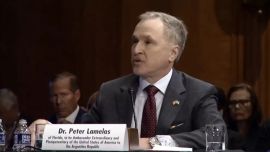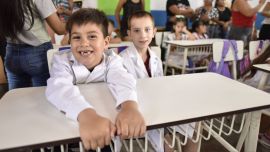Argentina’s economic crisis is not stopping. With inflation exceeding 250 percent per annum purchasing power falling, poverty is on the rise. And in the nation’s capital, this is translating into an increase of the number of homeless people on the streets. Buenos Aires City Security Minister Waldo Wolff says that 300 new people start living rough every month.
“We’ve had a monthly increase of nearly 10 percent over the last few months. There are 300 new people per month joining the ranks,” said Wolff in a recent television interview.
“We had 4,500 homeless people in April. The vast majority of those people come from Greater Buenos Aires. We have 47 shelters in the City which is more than decent. We have the capacity to accommodate them,” said the minister.
City Hall data shows inflation in Buenos Aires City reached 4.8 percent last month, 0.4 points up on May. Prices have increased 89 percent this year already. The Buenos Aires City Statistics and Census Bureau recently disclosed the numbers of poverty and destitution for the first quarter of the year. According to the report, 30.4 percent of homes (411,000 dwellings) and 35.1 percent of the population (1,083,000 people) are poor. Year-on-year, there has been an increase of 198,000 homes and 410,000 people falling into poverty.
In communication with Perfil, City Hall authorities said that Mayor Jorge Macri’s government has increased the number of assistance network teams going around the streets by 120 percent. This improvement comes despite the macroeconomic situation, they observed.
City Hall’s ‘Winter Protocol’ deploys a team of responders on the streets to assist homeless people amid low temperatures and encourages them to go to a shelter. Neighbours, via Hotline 108 and the City’s BOTI (11-5050-0147) WhatsApp service can call for aid for homeless people or any social emergency.
“The Care Networks work year-round, 24/7. During these very cold days police rounds intensify, especially in critical areas such as squares, underground stations and high traffic areas, for homeless people to access centres to shelter from the cold, and they are given a hot meal, toiletries and warm clothes,” the government said in a statement.
“There are over 60 mobile units of the Care Network in addition to pedestrian teams of the Human Development Ministry touring the City. All 47 Social Inclusion Centres work 24/7 on a case-by-case basis for homeless people to regain a life project. There are over 4,000 available spots,” it continued.
Irrespective of official data, government employees making nightly rounds explain that addressing the subject of shelters can be tense. Some local residents are fearful of reporting people living homeless, while some refuse to go to government shelters.
“We can’t force a person to go if they’re not committing any crimes. So it’s complicated. You can’t go to the police, but you have to convince them. And many times they don’t want to lose their spot on the street. Besides, they have a lot of stuff and they can’t take that to a shelter. So they don’t want to move either for fear of their belongings being stolen. That happens a lot. Lastly, those living with their family or pets are afraid of being around others who can be violent,” one official told Perfil, speaking anonymously.
The Buenos Aires City government tracks the number of homeless in the capital, though identifying all of those living rough is not feasible.
An April 2024 census of the homeless by its Human Development & Habitat Ministry showed that the majority of homeless were found in Comuna 1, with 420 identified in the barrios of Retiro, San Nicolás, Puerto Madero, San Telmo, Monserrat and Constitución.
In addition to the City centre, the largest populations of those living on the streets were found in Comuna 3 (156 people in Balvanera and San Cristóbal), Comuna 4 (137 in Pompeya, Parque Patricios, Barracas and La Boca) and Comuna 14 (99 in Palermo).
Out of the total 1,325 people surveyed in the report, 70 percent were living on the pavement, and the rest mostly at cashpoints. Of the respondents, 26 were children and teenagers under 18 years old.
As for place of birth, 31 percent of respondents were born in the capital, 32 percent in Buenos Aires Province and 16 percent in other provinces. Only 59 percent had an up-to-date Argentine DNI (National Identity Document) identification card.
It is true that some of those sleeping rough can be dangerous individuals, but the City Police’s treatment of individuals, including some involved in recent arrests, has been questioned.
During interactions with police, in which arrests were made, some homeless people have complained after they have had items, such as knives, confiscated by officers on the beat.
These actions have been deemed unlawful and unconstitutional by the courts of Buenos Aires City, which ruled the people were arrested without a warrant and on no valid grounds, other than the fact they are living in the street.
However, City Hall’s Public Prosecutors Office has since made a series of decisions which violate its duty of guaranteeing legality and could compromise Argentina’s international liabilities.
The Buenos Aires City’s Public Prosecutor’s Office endorsed the inadmissible harassment, even though Argentina was recently criticised by the Inter-American Court of Human Rights for similar cases. Some of those arrested were charged with possession of “unconventional weapons.” City prosecutors also appealed the court decision which nullified the arrests.
In addition to violating basic rights, these facts attest to the inefficient use of the ever limited resources of the Public Prosecutor’s Office, as well as a lack of concern by the General Prosecution Service over potential conflicts in the future.
City Hall’s approach, via the capital’s Prosecutor General, was laid out in a 2020-2024 Strategic Plan, which stated it is appropriate to “provide tools to facilitate socioeconomic insertion of people violating regulations, since exclusion from rights and social inequality can cause criminal behaviour.”
There is no criminal information or data that shows a street violence problem involving the possession of sharp elements by homeless people. And even if there was, the Public Prosecutor’s Office’s approach should be the implementation of a policy that makes a comprehensive impact on that problem, including measures to attend to the prior socioeconomic situation.
Instead of that, the City government and prosecution service are responding to a serious social problem with unlawful police action.




















Comments